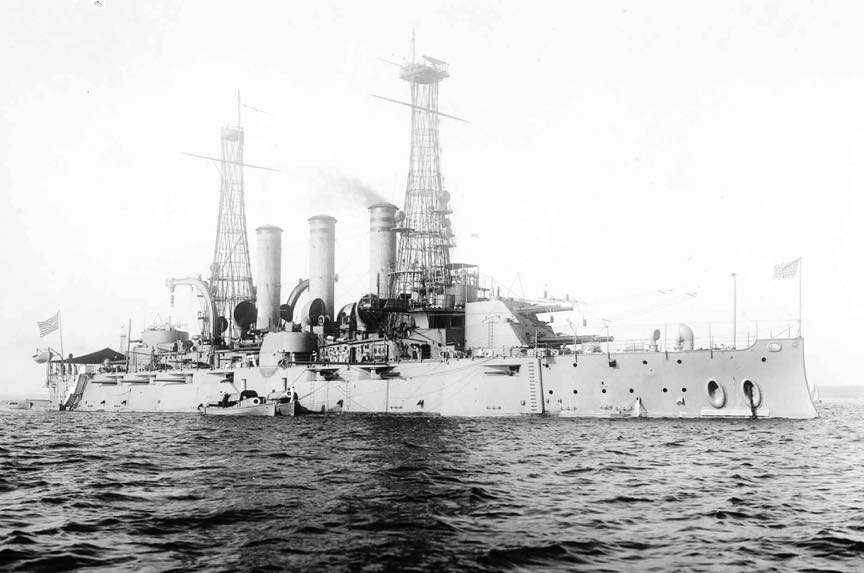Nebraska BB-14

Nebraska (BB-14: dp. 16,094; l. 441'3"; b. 76'2"; dr. 25'10"; s. 19 k.; cpl. 1,108; a. 4 12", 8 8", 12 6", 12 3", 4 21" tt.; cl. Virginia)
Nebraska (BB-14), formerly named Pennsylvania, was laid down by Moran Brothers in Seattle, Washington, on July 4, 1902. She was launched on October 7, 1904, sponsored by Miss Mary N. Mickey, daughter of Governor John H. Mickey of Nebraska, and commissioned on July 1, 1907, with Captain Reginald F. Nicholson in command.
After shakedown and alterations, the new battleship joined the "Great White Fleet" at San Francisco after May 6, 1908, replacing Alabama (BB-8).
Departing San Francisco on July 7, 1908, the Fleet visited Honolulu, Hawaii; Auckland, New Zealand; Sydney and Melbourne, Australia; Manila, Philippine Islands; Yokohama, Japan; and Colombo, Ceylon, arriving in Suez, Egypt, on January 3, 1909. Departing from Messina, Italy, on the 9th, the Fleet visited Naples, Italy, and then Gibraltar, arriving at Hampton Roads on February 22, where President Theodore Roosevelt reviewed the Fleet as it entered the roadstead.
Nebraska continued duty with the Atlantic Fleet. She attended the Hudson-Fulton Celebration in 1910 and the Louisiana Centennial in 1912. She earned the Mexican Service Medal for operations at Vera Cruz, Mexico, from May 1 to June 21, 1914, and from June 1 to October 13, 1916. After a period of reduced commissioned service, she was fully commissioned again on April 3, 1917.
When war was declared on April 6, 1917, Nebraska was undergoing repairs at the Boston Navy Yard, attached to the 3rd Division, Battleship Force, U.S. Atlantic Fleet. On April 13, 1917, she departed Boston to engage in maneuvers and battle practice with the fleet in the Chesapeake Bay area. She operated along the East Coast, primarily training armed guard crews for American merchantmen, until entering the Norfolk Navy Yard on April 15, 1918, for repairs.
At Hampton Roads on May 16, she received onboard the body of the late Carlos M. DePena, Envoy Extraordinary and Minister Plenipotentiary from Uruguay, with full honors. Departing Hampton Roads the same day, she arrived in Montevideo on June 10 in the company of Pittsburgh (ACR-4), flagship of the Pacific Fleet. The Commander in Chief, U.S. Pacific Fleet, came onboard for the ceremonies, and the body of the late Uruguayan Minister to the United States was transferred with full honors. Nebraska departed Montevideo on June 15 for home, arriving at Hampton Roads on July 26.
The battleship departed New York on September 17 as the principal escort for a fast merchant convoy of 18 ships to an eastern Atlantic rendezvous, returning to Hampton Roads on October 3. Nebraska made two more convoy voyages in the Atlantic, returning from the latter on December 2 to prepare for service in returning American troops from France.
Nebraska made four voyages from the United States to Brest, France, transporting 4,540 troops to and from the United States. On her first trip, she departed Hampton Roads on December 30, 1918, arrived in Brest on January 11, 1919, and returned to Newport News on January 28. Her final voyage to return veterans from France ended when she arrived in Newport News, Virginia, on June 21 with 1,279 troops.
On June 22, 1919, Nebraska was detached from the transport service and shortly thereafter sailed to join Division 2, Squadron 1, U.S. Pacific Fleet, for operations along the West Coast under the command of Captain P. N. Olmstead. She was decommissioned on July 2, 1920.
In accordance with the Washington Treaty limiting naval armament, Nebraska was rendered incapable of further warlike service on November 9, 1923, and was sold for scrap a few weeks later.
 >
>